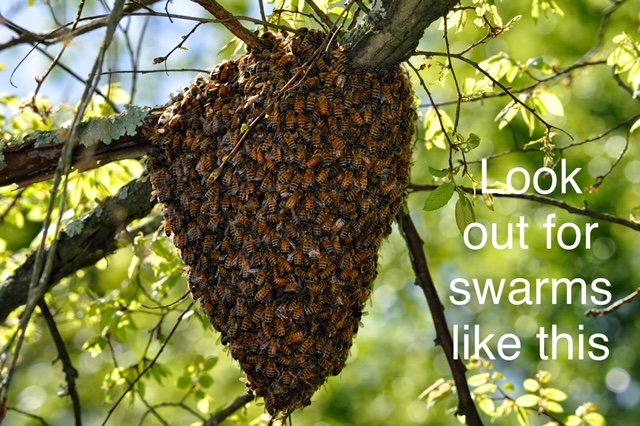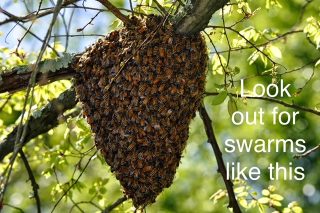
Another crazy few weeks – I need the roundabout to stop now so I can get off! It started with me being very organised and checking each of my hives to see which ones needed extra super space. I made a recording on my phone at each hive to say what was needed – a WBC super and lift on Hive 1, a National super on Hive 2, etc. I then came to a hive which, once I had lifted the roof, I could immediately see had hundreds of bees on the crown-board. Since I was not wearing any protective gear, I immediately replaced the roof and just recorded “Hive 7 needs WBC super” and resolved to make that my first task once I was kitted up. Later that day, I went back to Hive 7 with the spare super and lifted the roof to see where I should start in terms of clearing the bees prior to adding the super. It was then I noticed how heavy the roof was – much heavier than I would have expected. As I lifted the roof away from the hive a piece of honey comb fell onto the crown-board – and I could immediately see what was going on. The bees had presumably run out of room in the hive and decided to extend their storage space in the area below the roof. Planning ahead a week or so before, I had placed an extra lift on many of my hives in readiness for the additional supers that were to be added later. In this hive, this left a void between the crown-board and the roof – a nice sized volume for comb building. However, the bees were not behaving as I would have expected. They were flying away from the hive and others were arriving, whereas I was expecting them to be working on the comb and possibly going back into the hive where they came from. It then dawned on me – this was a swarm, not bees from the hive! A swarm that had found an entrance between the roof and the uppermost lift into a colony-sized space which suited its requirements to a T!
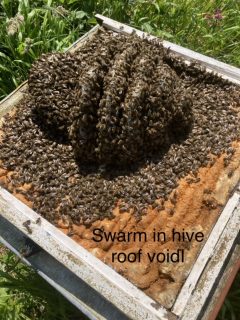
I turned the roof over but because it was such a hot day and the weather had been hot for so long, the wax was extremely soft so the combs just gracefully collapsed – they were full of honey and the weight was too much for the soft structure to support. A quick visit to the bee shed to retrieve an empty brood box, empty frames and a pile of elastic bands and I was ready to transfer the collapsed combs and their bees into a hive of their own. This was achieved without too much trouble, cutting the combs off the roof and placing them inside empty frames to be held in place by the elastic bands – and the bees were as docile as anything – they allowed me to do whatever I was doing with no attempt to stop me or deter me. Quite a pleasure to work with and they appear quite content with their new accommodation. That swarm is now still on top of the original hive whose occupants are oblivious to their upstairs neighbours, though I must set up the interlopers on their own stand shortly.
Walking back through the apiary after I had finished the swarm transfer, I spotted another swarm in the central tree, so I brushed them into my swarm box and set them up underneath the tree until the evening. The following day, another swarm in the tree at exactly the same spot on the branch – this is getting silly now! Into another swarm box ready for hiving – but I’m starting to run out of spare equipment now, as are the major bee supplies companies. The demand for nucleus hives has pushed them to their limits because this year’s swarming season has been so busy. I had to hive this swarm on two nucleus boxes, one on top of the other as I had no more floors to support a brood box, but the bees are quite happy and working the nectar flow very enthusiastically. The first swarm I hived alongside a very weak colony with few bees that had, a short while ago, been strong. Presumably it had swarmed so the plan was to unite the two after the swarm was ensconced.
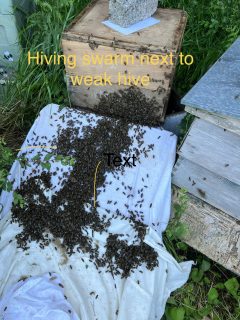
The next morning, on checking the swarm hive, I found it was empty – they had gone! A quick scout around the apiary showed no sign of the absconders, but then I noticed that the weak hive was magically strong again! The swarm had presumably decided next door was a better option and united themselves with the remains of the weak colony! There were no dead bees to be seen, so there had been no opposition to this move – and they saved me a job! Bees are so clever!
To round off another swarm-crazy day, a call to say there’s a swarm in the shed roof bait hive at my friend’s. This is getting really silly now and the swarming season has only just started!
Two days later another swarm in my apiary tree – a really big one this time. Could it have come from the weak hive I just spoke about? Perhaps.
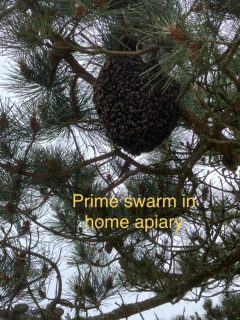
I brushed them down into a swarm box – but it was spitting with rain, so in order to preserve the integrity of my (cardboard) swarm box – and the bees – I covered it with an inverted dustbin (did I say you needed spare dustbins to be a beekeeper?!!).

I subsequently hived this into a jumbo brood box and one week later placed a queen excluder and super on top, as there were so many bees.
One of the things I like about swarms is that when hiving them, I empty the bees from the swarm box onto a white sheet spread across a ramp up to the hive entrance. Once the queen has found her way into the hive, or sometimes even before this when a few bees have gone in and decided it’s a suitable home for their colony, several bees set themselves up at the entrance and start fanning their opened Nasenov glands (which are located at the end of the abdomen). The scent is a homing scent to say either that the queen is there or that they think the hive is suitable for them. The other bees then head for that scent and to watch them march so rapidly and intently towards their new home is a wondrous sight – quite often the queen can be seen scrambling over the backs of her daughters to get in as soon as she can. I love it!
The last swarm call so far (apart from roof and chimney swarms, which have been very popular this year) was to a swarm on the road. The caller said it had fallen from a tree colony above the road, so I was keen to collect it. When I arrived at the swarm, the caller had set up traffic cones and was guiding confused drivers around this small black patch on the road that looked like a pot-hole.
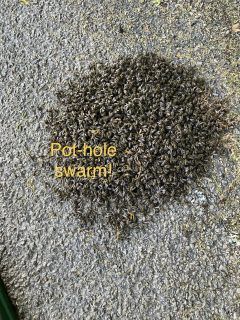
But how best to get it into my swarm box. Sweeping would be the standard approach to a 2D structure of bees (as when they are on the tree branch n my apiary), but I would be rolling the bees along a rough surface. The bees, firstly, would not like that and would likely take to the air and that would be the end of my collecting them. Secondly, it could damage them – especially the queen. If the queen was damaged the bees would reject her and without any brood from which they could raise a new queen that would be the end of the colony. So how to get them in the box? In the end, I placed my swarm box over the disc of bees, propped up at one corner on the base of a traffic cone, and within 60 seconds – literally – the majority of the bees were inside. They could smell comb from previous swarms and it was dark, “Perfect” they thought and in they went. The odd half dozen or so that hadn’t gone in were picked up on my brush and dropped into the box. Job done! That same evening, I hived them alongside a small swarm already hived with the intention of uniting them if necessary but once they were on the white cloth on the ramp they rushed up to the hive entrance and eventually all went in.
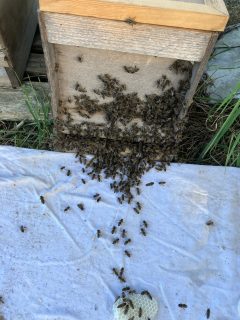
Judging by their behaviour since, I don’t think I’ll need to unite them. They have been flying strongly and look as if they are able to hold their own. We’ll see!
Apart from swarms, what else? Well, I have taken off a Spring crop of honey, which is really pleasing because Spring honey is so different from the main crop honey. There has been a major nectar flow during this recent hot spell and the bees have been going crazy on it. I normally expect to take a Spring crop about every four years, so I’m ready for this! The supers I took were full and really heavy!
There have been two reported sightings of Asian Hornet in Kent during May, the first at Ashford and the second at Canterbury. The NBU collected both insects and are now analysing their find. Bearing in mind that sightings have been made as far north as Northumberland, this year, we cannot afford to rest on our laurels, so do please keep a look-out for this invasive and destructive species.

Enjoy the fine summer weather.
Colin Rees 07939 971104 01872 501313 colinbeeman@aol.com

